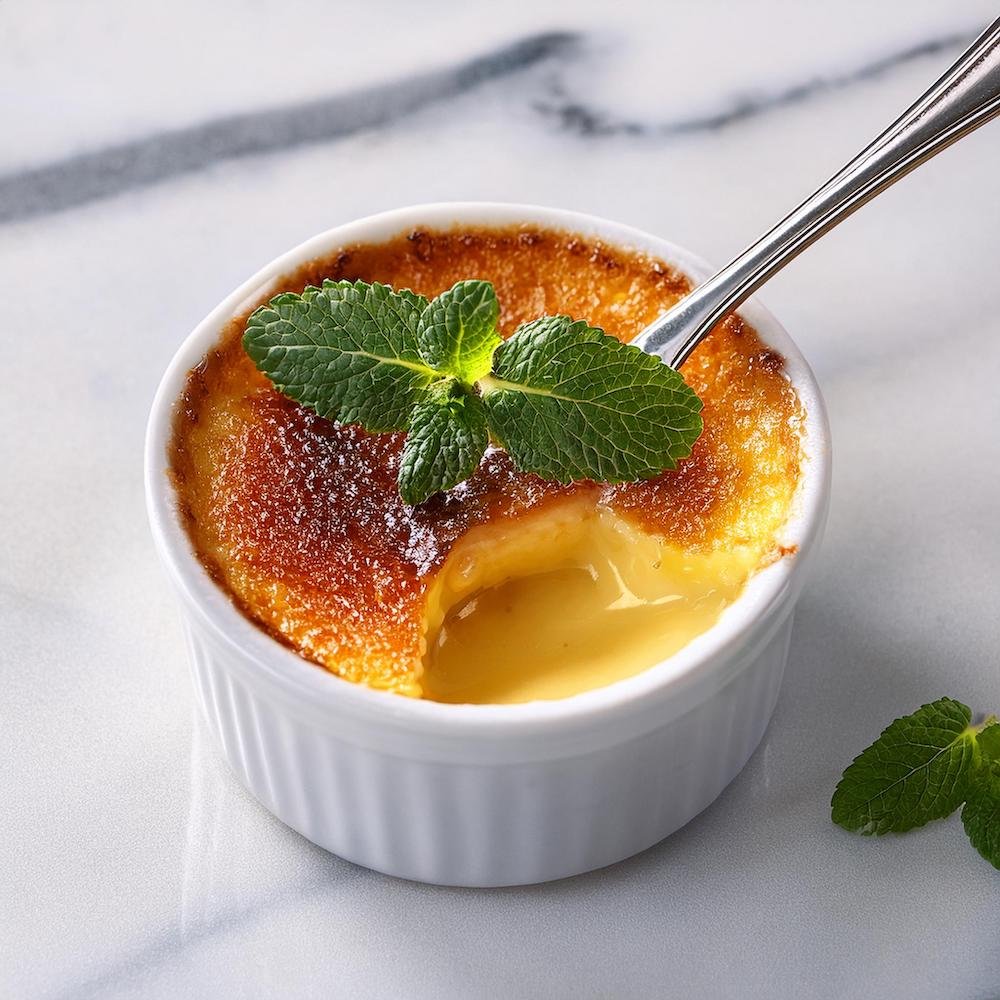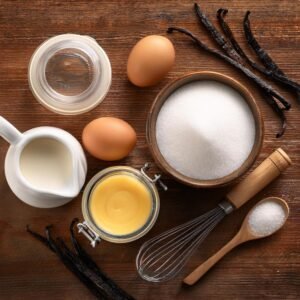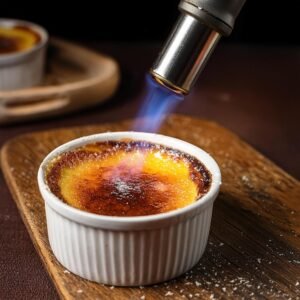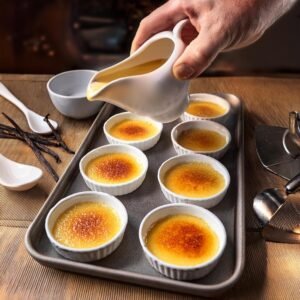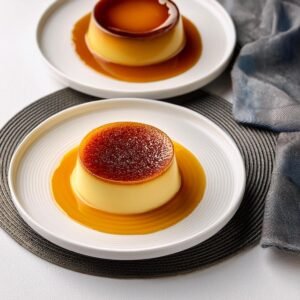What is Crème brûlée mostly Made Of? Crème brûlée is one of the most iconic French desserts, celebrated for its rich, velvety custard base and signature caramelized sugar crust. Despite its sophisticated appearance, crème brûlée is surprisingly simple to make and relies on a small list of essential ingredients. Each component works harmoniously to create a dessert that is both elegant and indulgent.
Understanding what crème brûlée is mostly made of—and why each ingredient matters—can help you perfect this classic treat. Whether you’re making it for a dinner party or indulging in a quiet moment at home, mastering the basic ingredients will elevate your baking skills.
In this guide, we’ll break down the core ingredients of crème brûlée, explain their roles, and share tips for selecting the best quality items to ensure flawless results.
The Core Ingredients of Crème Brûlée
At its heart, crème brûlée is made with just four primary ingredients. These simple components combine to create the perfect balance of creamy texture and sweet flavor.
Heavy Cream
- Why It’s Essential:
- Heavy cream is the foundation of the custard, providing its luxurious, smooth texture. The high fat content gives crème brûlée its rich and velvety mouthfeel.
- Substitutions:
- Avoid using milk or light cream, as they don’t have enough fat to create the desired creamy consistency.
Pro Tip: For added flavor, gently heat the cream with a split vanilla bean or other aromatics before mixing it with the eggs.
Egg Yolks
- Purpose:
- Egg yolks are the custard’s thickening agent, binding the mixture together as it bakes. They give crème brûlée its silky, pudding-like consistency.
- Why Only Yolks?:
- Using just the yolks (and not the whites) ensures a creamy texture without becoming too firm or rubbery.
Pro Tip: Use fresh, large egg yolks for the best results. Whisk them gently to avoid incorporating too much air, which can create bubbles in the custard.
3. Sugar
- Custard Sweetener:
- Granulated sugar is added to sweeten the custard mixture, balancing the richness of the cream and egg yolks.
- Caramelized Topping:
- A thin layer of sugar is melted and caramelized to create the signature crisp, golden-brown crust on top.
Best Sugar for the Topping:
- Use regular granulated sugar or superfine sugar for an even caramelization. Avoid powdered sugar, as it won’t caramelize properly.
4. Vanilla
- Flavor Foundation:
- Vanilla is the key flavor in crème brûlée. It adds a warm, aromatic sweetness that enhances the custard’s richness.
- Best Options:
- Vanilla Bean: Split and scrape a vanilla bean for the most intense flavor and beautiful specks in the custard.
- Pure Vanilla Extract: A high-quality extract is a great alternative if vanilla beans aren’t available.
Pro Tip: Avoid artificial vanilla, as it lacks the depth and complexity of natural vanilla flavor.
How Each Ingredient Works Together
The magic of crème brûlée lies in the harmony of its simple ingredients. Each component plays a unique role, contributing to the dessert’s iconic texture, flavor, and appearance. Understanding how these ingredients interact ensures you can create a flawless crème brûlée every time.
Heavy Cream – The Rich Base
- Role:
- Heavy cream provides the smooth, velvety foundation of the custard. Its high fat content (about 36–40%) ensures a rich mouthfeel that sets crème brûlée apart from lighter desserts.
- Interaction:
- When heated, cream blends seamlessly with egg yolks, creating a stable custard mixture. The gentle baking process allows the cream’s richness to shine without curdling.
Pro Tip: Infusing the cream with a vanilla bean, citrus zest, or spices like cinnamon adds extra depth to the custard without overpowering its simplicity.
Egg Yolks – The Thickener
- Role:
- Egg yolks are the custard’s thickening agent. When combined with cream and gently heated, the proteins in the yolks coagulate, transforming the liquid mixture into a firm yet creamy texture.
- Interaction:
- The yolks bind the cream and sugar, creating a custard that sets evenly. Whisking them gently avoids introducing air, ensuring a dense, silky texture with no bubbles.
Pro Tip: Always temper the egg yolks by adding warm cream slowly. This prevents the eggs from scrambling and keeps the custard smooth.
Sugar – Sweetness and Caramelization
- In the Custard:
- Sugar balances the richness of the cream and eggs, enhancing the flavor without making the dessert overly sweet.
- On Top – The Crust:
- The sugar layer caramelizes under high heat, forming a crispy, glass-like crust that contrasts beautifully with the creamy custard beneath.
Interaction:
- When exposed to a kitchen torch or broiler, sugar melts, bubbles, and cools into a brittle, golden-brown topping.
Pro Tip: Use a thin, even layer of sugar for the topping. Too much sugar can create a thick, hard crust, while too little may not caramelize evenly.
Vanilla – The Signature Flavor
- Role:
- Vanilla provides the primary flavor in crème brûlée, complementing the custard’s rich, creamy base with warm, sweet, and aromatic notes.
- Interaction:
- Infusing vanilla into the cream ensures even distribution of flavor throughout the custard. Vanilla beans add visual appeal with their tiny black specks.
Pro Tip: If using vanilla extract, add it after the cream has cooled slightly to preserve its flavor. Heating extract too much can cause it to evaporate.
These four ingredients work together to create the perfect balance of flavor, texture, and contrast in crème brûlée. The creamy custard, rich vanilla notes, and crunchy caramelized sugar crust form a dessert that is both simple and elegant.
Optional Flavor Additions
While the classic crème brûlée relies on its signature vanilla flavor, you can experiment with a variety of additions to customize and elevate this elegant dessert. From subtle citrus notes to bold chocolate infusions, these variations can bring exciting twists to the traditional recipe.
Citrus Zest
- Why It Works:
- Adding the zest of lemon, orange, or lime enhances the custard with refreshing, tangy undertones that complement its richness.
- How to Use It:
- Add the zest to the cream while heating to allow the natural oils to infuse flavor. Strain the cream before mixing it with the egg yolks to avoid any bitterness.
Pro Tip: Use a microplane grater for fine, delicate zest that won’t overpower the dessert.
Espresso or Coffee
- Why It Works:
- The bitterness of espresso or strong coffee balances the sweetness of the custard, creating a rich and sophisticated flavor profile.
- How to Use It:
- Add 1–2 tablespoons of cooled espresso or coffee to the cream mixture before combining it with the egg yolks.
Pro Tip: Pair coffee-infused crème brûlée with chocolate shavings for an indulgent mocha twist.
Chocolate
- Why It Works:
- Adding melted chocolate to the custard results in a decadent, chocolatey version of crème brûlée that’s perfect for chocoholics.
- How to Use It:
- Mix 2–3 ounces of finely chopped dark, milk, or white chocolate into the warm cream until fully melted and smooth. Combine with the egg yolk mixture as usual.
Pro Tip: Use dark chocolate for a rich, bold flavor, or white chocolate for a sweeter, creamier variation.
Liqueurs (Non-Alcoholic Substitutes Included)
- Why It Works:
- Liqueurs like Grand Marnier, Amaretto, or Irish cream add depth and complexity to the custard.
- How to Use It:
- Add 1–2 tablespoons of liqueur or non-alcoholic flavoring (e.g., almond extract, orange extract) to the custard mixture before baking.
Pro Tip: For a family-friendly version, use flavored syrups (like almond or hazelnut syrup) instead of alcoholic liqueurs.
Spices
- Why It Works:
- Spices like cinnamon, nutmeg, or cardamom can add a warm, cozy twist to the custard, perfect for the fall or winter seasons.
- How to Use It:
- Infuse ½ teaspoon of your chosen spice into the cream while heating, then strain before combining with the eggs.
Pro Tip: A dusting of cinnamon or nutmeg on the caramelized sugar crust adds an extra touch of flavor and visual appeal.
Coconut Milk
- Why It Works:
- Replacing part of the heavy cream with coconut milk gives the custard a tropical flavor while maintaining its creamy consistency.
- How to Use It:
- Substitute up to half of the heavy cream with full-fat coconut milk and proceed with the recipe as usual.
Pro Tip: Garnish with toasted coconut flakes for added texture and flavor.
By experimenting with these optional flavor additions, you can customize crème brûlée to suit any occasion or preference. Whether you stick to classic vanilla or try bold combinations like chocolate-espresso or citrus-spice, this versatile dessert will always impress.
Choosing Quality Ingredients
The key to a perfect crème brûlée lies in the quality of its ingredients. Since the recipe relies on only a few components, selecting the best possible versions will enhance both the flavor and texture, elevating your dessert to restaurant quality. Here’s how to choose the right ingredients:
Heavy Cream
- Why It Matters:
- Heavy cream provides the rich, velvety base for crème brûlée. High-fat content (36–40%) ensures a smooth, luxurious texture.
- What to Look For:
- Choose fresh, full-fat heavy cream without additives like stabilizers or thickeners. Avoid substituting with light cream or milk, as they won’t deliver the same creaminess.
Pro Tip: Organic heavy cream tends to have a fresher and cleaner flavor, which makes a difference in the final dessert.
Egg Yolks
- Why It Matters:
- Egg yolks thicken the custard and provide a rich, silky texture. Fresh, high-quality yolks ensure the custard sets properly and tastes rich.
- What to Look For:
- Use large, farm-fresh eggs with vibrant yellow yolks for better flavor and a golden color.
Pro Tip: Separate the yolks carefully to avoid including egg whites, which can change the custard’s consistency.
3: Sugar
- Why It Matters:
- Sugar sweetens the custard and forms the signature caramelized crust that makes crème brûlée unique.
- What to Look For:
- Use regular granulated sugar for the custard and the topping. Granulated sugar melts evenly, creating a smooth, glass-like caramel layer.
- Avoid powdered or coarse sugars, as they won’t caramelize as consistently.
Pro Tip: If you prefer a quicker caramelization, use superfine sugar for the topping. It melts more evenly under a kitchen torch.
Vanilla
- Why It Matters:
- Vanilla is the primary flavor in classic crème brûlée, adding warmth and depth to the custard.
- What to Look For:
- Vanilla Beans: Fresh vanilla beans offer the most intense and authentic flavor, with tiny black specks that enhance the custard’s appearance. Split the bean and scrape out the seeds to infuse the cream.
- Pure Vanilla Extract: If vanilla beans aren’t available, use high-quality pure vanilla extract. Avoid artificial flavoring, as it lacks depth.
Pro Tip: To maximize flavor, steep the vanilla bean in the cream while it heats, then remove it before mixing with the eggs.
Additional Flavor Enhancers
- Citrus Zest: Use fresh zest from lemons, oranges, or limes to add a subtle tang.
- Spices: Freshly ground cinnamon, nutmeg, or cardamom can give the custard a cozy warmth.
- Infusions: Experiment with ingredients like coffee, chocolate, or coconut milk for creative variations.
Pro Tip: When infusing flavors (like zest or spices), always strain the cream mixture before combining it with egg yolks to maintain a smooth consistency.
By carefully selecting the freshest and highest-quality ingredients, you’ll ensure your crème brûlée has the rich, creamy custard and perfectly crisp topping that make this dessert so special.
Step-by-Step Guide to What Is Crème Brûlée Mostly Made Of?
Creating a perfect crème brûlée may seem intimidating, but it’s a simple process when broken down into clear, manageable steps. Follow this guide to achieve a silky custard and the signature caramelized sugar crust every time.
1 – Gather Ingredients and Tools
Before you begin, ensure you have all the necessary ingredients and tools:
- Ingredients:
- 2 cups heavy cream
- 5 large egg yolks
- ½ cup granulated sugar (plus extra for caramelizing the top)
- 1 vanilla bean (or 2 teaspoons pure vanilla extract)
- Tools:
- 4–6 ramekins (4–5 oz each)
- Whisk and mixing bowls
- Fine-mesh sieve
- Baking dish (for the water bath)
- Kitchen torch (or broiler)
2 – Prepare the Custard Mixture
- Heat the Cream:
- In a medium saucepan, heat the heavy cream over medium heat until it begins to steam. Do not let it boil.
- If using a vanilla bean, split it lengthwise, scrape the seeds into the cream, and add the pod to infuse flavor. Remove the pod after heating.
- Whisk the Yolks and Sugar:
- In a mixing bowl, whisk the egg yolks and sugar together until the mixture turns pale yellow and slightly thickened.
- Temper the Egg Yolks:
- Gradually pour the warm cream into the yolk mixture, whisking constantly. This step prevents the eggs from scrambling.
- Strain the Mixture:
- Pour the custard through a fine-mesh sieve into a clean bowl or pitcher to remove any bits of cooked egg or air bubbles.
3 – Fill and Bake
- Fill the Ramekins:
- Divide the custard evenly among the ramekins, filling each about ¾ full.
- Create a Water Bath:
- Place the ramekins in a deep baking dish. Pour hot water into the dish until it reaches halfway up the sides of the ramekins.
- Bake:
- Preheat the oven to 325°F (160°C). Bake for 30–40 minutes, or until the custard is set but slightly jiggly in the center.
- Cool the Custards:
- Remove the ramekins from the water bath and let them cool at room temperature. Then refrigerate for at least 2–4 hours (or overnight) to fully set.
4 – Caramelize the Sugar
- Add the Sugar Topping:
- Just before serving, sprinkle 1–2 teaspoons of granulated sugar evenly over the surface of each custard. Tilt the ramekin to ensure full coverage.
- Torch the Sugar:
- Use a kitchen torch to melt and caramelize the sugar. Move the flame in small, circular motions to evenly melt the sugar until it turns golden-brown and crisp.
- Broiler Method (Alternative):
- If you don’t have a torch, place the ramekins under a preheated broiler for 1–2 minutes. Watch closely to prevent burning.
Pro Tip: Allow the caramelized sugar to cool for 1–2 minutes before serving to achieve the perfect crack when tapped with a spoon.
5 – Serve and Enjoy
- Final Touches:
- Garnish with fresh berries, a sprig of mint, or a dusting of powdered sugar for an elegant presentation.
- Serving Temperature:
- Serve crème brûlée chilled with a slightly warm sugar crust for the best flavor and texture contrast.
This step-by-step guide simplifies the process, ensuring you achieve a creamy custard and crisp caramelized sugar topping every time. Crème brûlée may look refined, but with these steps, you’ll be able to master this classic dessert effortlessly.
FAQs
What Is a Crème Brûlée Made Of?
Crème brûlée is made from four core ingredients:
Heavy Cream: The base of the custard, providing a rich and velvety texture.
Egg Yolks: The thickening agent that helps set the custard during baking.
Sugar: Added for sweetness in the custard and used to create the caramelized topping.
Vanilla: Adds the signature flavor, typically from vanilla beans or pure vanilla extract.
These simple ingredients come together to form the creamy, indulgent dessert topped with a crisp, golden caramelized sugar crust.
What Is the Secret to Crème Brûlée?
The secret to perfect crème brûlée lies in mastering three key techniques:
Gentle Baking: Use a water bath (bain-marie) to bake the custard slowly and evenly at a low temperature (325°F/160°C) to prevent curdling or cracking.
Perfect Caramelization: Sprinkle an even, thin layer of sugar and use a kitchen torch (or broiler) to melt and caramelize it into a crisp, golden crust.
Quality Ingredients: Use heavy cream, fresh egg yolks, and high-quality vanilla to achieve a smooth, flavorful custard.
These steps ensure a silky custard with a crunchy topping that cracks beautifully when tapped with a spoon.
Is Crème Brûlée Basically Custard?
Yes, crème brûlée is essentially a baked custard.
The custard is made by combining heavy cream, egg yolks, sugar, and vanilla, then baking it gently in a water bath until set.
What sets crème brûlée apart is the caramelized sugar crust on top, which adds a crunchy texture and a signature crack when served.
While custards come in many variations, crème brûlée is defined by its creamy texture and rich caramelized topping.
Is Crème Brûlée Basically Flan?
Crème brûlée and flan are both custard-based desserts, but they have distinct differences:
Caramelization: Crème Brûlée: Has a hard caramelized sugar crust created on top by torching or broiling sugar just before serving.
Flan: Features a soft caramel sauce that is baked underneath the custard and poured over the top when served.
Texture: Crème Brûlée: Creamier and denser, thanks to its rich heavy cream base.
Flan: Lighter and more gelatinous due to the use of milk or a mix of milk and cream.
Serving Style: Crème Brûlée: Served in the same ramekin it’s baked in, with the caramelized sugar topping.
Flan: Inverted onto a plate, showcasing the caramel sauce.
In short, while both desserts are custards, their caramel preparations, textures, and serving styles make them unique.
Suggested Internal Links :
- What Is the Secret to Crème Brûlée?
Learn the techniques and tips that elevate this classic dessert from good to exceptional. - What’s the Difference Between Crème Brûlée and Custard?
Explore how crème brûlée differs from other custard-based desserts in preparation and flavor. - What Type of Cream is Best for Crème Brûlée?
Dive deeper into how the choice of cream impacts the texture and taste of crème brûlée. - How to Make a Unicorn Cake?
Discover creative dessert-making tips that can also be applied to perfecting crème brûlée. - Small Batch Chocolate Chip Cookies Recipe
Pair these cookies with crème brûlée for a satisfying and indulgent dessert duo.
Conclusion
Crème brûlée is a timeless dessert that embodies simplicity and elegance. If you’ve ever wondered, What is crème brûlée mostly made of?, the answer lies in just four key ingredients: heavy cream, egg yolks, sugar, and vanilla. These elements come together to create a rich, creamy custard topped with a perfectly caramelized sugar crust, offering a delicate balance of indulgent flavors and satisfying textures.The secret to mastering crème brûlée lies in precision and attention to detail. From baking gently in a water bath to using high-quality ingredients and perfecting the caramelized sugar topping, every step plays a vital role in achieving its iconic appeal. While this dessert shares its custard foundation with others like flan, its luxurious texture and signature sugar crust set it apart.
Now that you understand what is crème brûlée mostly made of and the techniques to perfect it, you can confidently bring this classic dessert to life in your kitchen. With a little practice, you’ll be able to delight family and guests alike with its sophisticated charm and irresistible flavor. Master the art of crème brûlée and enjoy creating this iconic treat that’s as enjoyable to make as it is to eat!
Craving more tasty recipes? Make sure to follow us on Facebook , Instagram, Pinterest, and Twitter for daily updates and kitchen inspiration!
